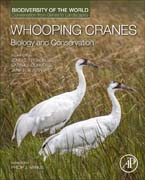
Whooping Cranes: Biology and Conservation
Nyhus, Philip J.
French, John B
Converse, Sarah J.
Austin, Jane E.
Whooping Cranes: Biology and Conservation covers one of the most endangered birds in North America and the research and conservation activity being conducted. It summarizes current biological information on Whooping Cranes and provides the basis for future research. The book concentrates on work completed in the past 20 years on population biology, behavior and social structure, habitat use, disease and health, captive breeding, and Whooping Crane conservation. Information presented comes from the study and management of remnant and reintroduced populations of Whooping Cranes in the field, from experimentation and breeding of captive Whooping Cranes, reintroducing the species to the wild, and challenges. The book seeks to inform and galvanize action dedicated to meeting the challenges faced by Whooping Crane managers and conservationists. Thus, it describes one model of endangered species conservation and restoration that will interest a wide audience. Presents a comprehensive treatment of the biology and ecology of Whooping Cranes, including biology of both remnant and reintroduced populations of Whooping CranesDescribes efforts over the past 45 years on conservation and the challenges of reintroducing an endangered speciesIncludes chapters from a variety of disciplinary and scale perspectives, ranging from evolution, to population ecology, behavior, habitat use, large landscape conservation, conflict, and conservation effortsFeatures contributions that are readable, yet technically complete and fully referenced Provides an example of partnership and collegial action that integrates information produced by scientific research and operational wildlife managementEdited and written by the leading Whooping Crane scholars and practitioners focused on this high-profile species of conservation concern INDICE: 1. Whooping Cranes, past and present 2. Taxonomy of cranes 3. Historical distribution of the Whooping Crane 4. Population dynamics and environmental factors of the Aransas-Wood Buffalo Whooping Crane population 5. Estimating recruitment and population size of the Aransas-Wood Buffalo population of Whooping Cranes 6. Location, timing, and cause-specific mortality of Aransas-Wood Buffalo Whooping Cranes 7. Population dynamics of reintroduced Whooping Cranes 8. Reproductive success in the Eastern Migratory Population of Whooping Cranes 9. Breeding biology of non-migratory Whooping Cranes in Florida 10. Pairing dynamics of reintroduced migratory Whooping Cranes 11. Movement ecology of reintroduced migratory Whooping Cranes 12. Applications of a mechanistic model as a non-invasive tool to improve understanding of Whooping Crane ecology, energetics, and behavior 13. Whooping Crane habitat selection at Aransas National Wildlife Refuge 14. Assessing habitat requirements for the reintroduction of an Eastern Migratory 15. Habitat selection in recently reintroduced Whooping Cranes: Wisconsin 16. Advances in captive breeding and management of captive populations of Whooping Cranes 17. Reproduction and reproductive technologies relevant to management of Whooping Cranes ex situ 18. Assessing health in the Aransas-Wood Buffalo Whooping Crane population 19. Health and disease treatment in captive and reintroduced Whooping Cranes 20. Comparing methods of release of juvenile Whooping Cranes 21. The operation of an ultralight-led migration: goals, successes, challenges 22. Louisiana non-migratory Whooping Crane reintroduction 23. Shooting deaths of Whooping Cranes 24. Future of Whooping Crane conservation and science
- ISBN: 978-0-12-803555-9
- Editorial: Academic Press
- Encuadernacion: Rústica
- Páginas: 466
- Fecha Publicación: 10/06/2018
- Nº Volúmenes: 1
- Idioma: Inglés
- Inicio /
- /
